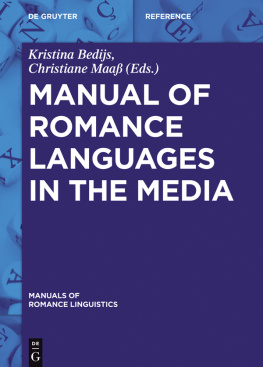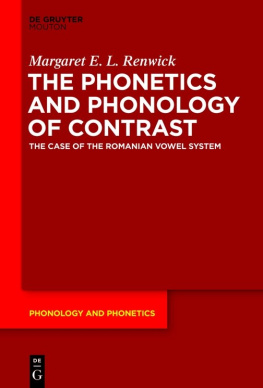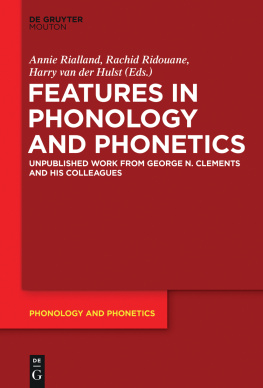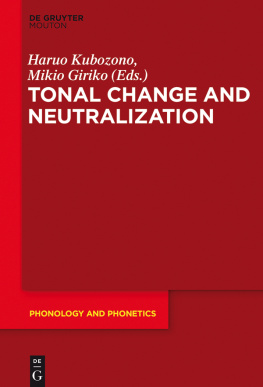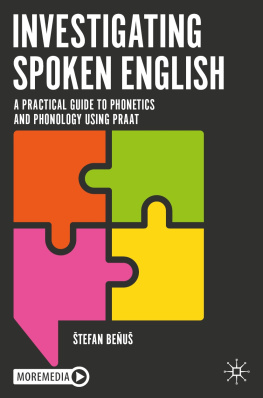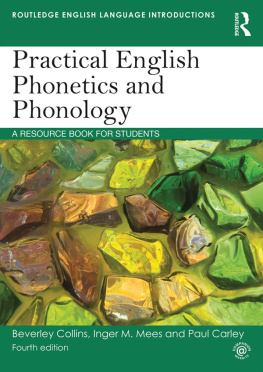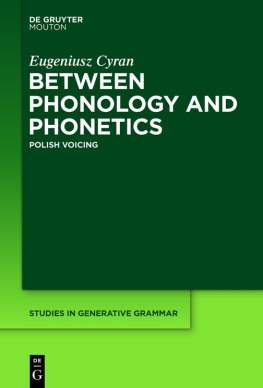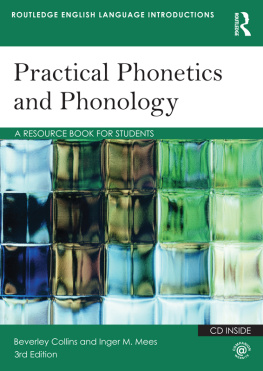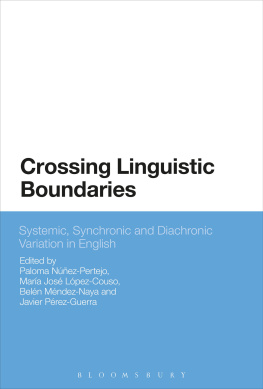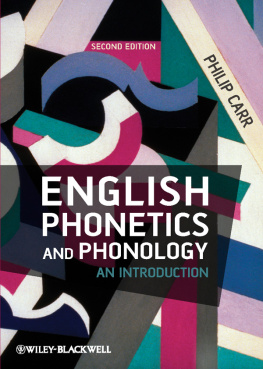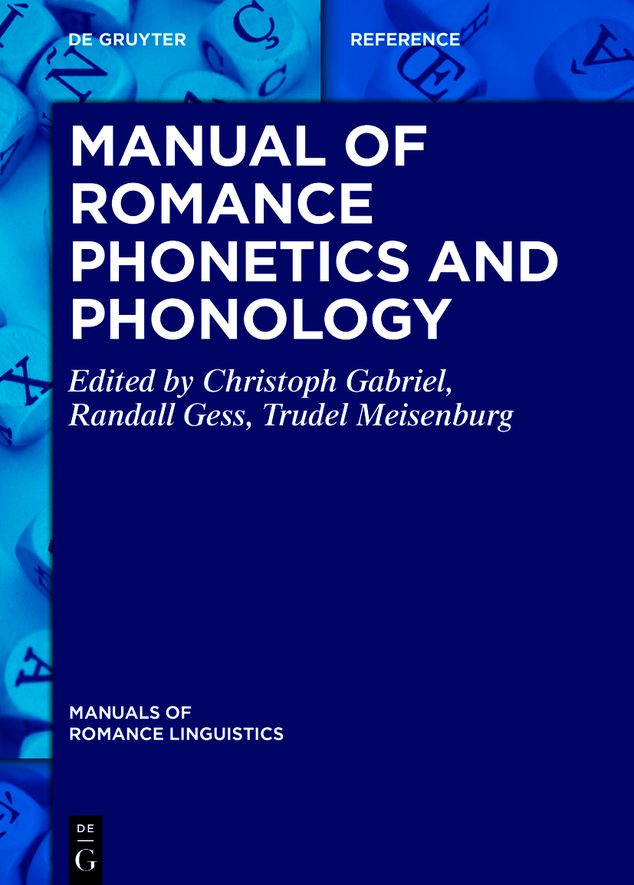Manuals of Romance Linguistics
Manuels de linguistique romane Manuali di linguistica romanza Manuales de lingstica romnica
Edited by
Gnter Holtus
Fernando Snchez-Miret
Volume
ISBN 9783110548358
e-ISBN (PDF) 9783110550283
e-ISBN (EPUB) 9783110548679
Bibliographic information published by the Deutsche Nationalbibliothek
The Deutsche Nationalbibliothek lists this publication in the Deutsche Nationalbibliografie; detailed bibliographic data are available on the Internet at http://dnb.dnb.de.
2022 Walter de Gruyter GmbH, Berlin/Boston
Manuals of Romance Linguistics
The international handbook series Manuals of Romance Linguistics (MRL) offers an extensive, systematic and state-of-the-art overview of linguistic research in the entire field of present-day Romance Studies.
MRL aims to update and expand the contents of the two major reference works available to date: Lexikon der Romanistischen Linguistik (LRL) (19882005, vol. 18) and Romanische Sprachgeschichte (RSG) (20032008, vol. 13). It will also seek to integrate new research trends as well as topics that have not yet been explored systematically.
Given that a complete revision of LRL and RSG would not be feasible, at least not in a sensible timeframe, the MRL editors have opted for a modular approach that is much more flexible:
The series will include approximately 60 volumes (each comprised of approx. 400600 pages and 1530 chapters). Each volume will focus on the most central aspects of its topic in a clear and structured manner. As a series, the volumes will cover the entire field of present-day Romance Linguistics, but they can also be used individually. Given that the work on individual MRL volumes will be nowhere near as time-consuming as that on a major reference work in the style of LRL, it will be much easier to take into account even the most recent trends and developments in linguistic research.
MRLs languages of publication are French, Spanish, Italian, English and, in exceptional cases, Portuguese. Each volume will consistently be written in only one of these languages. In each case, the choice of language will depend on the specific topic. English will be used for topics that are of more general relevance beyond the field of Romance Studies (for example Manual of Language Acquisition or Manual of Romance Languages in the Media).
The focus of each volume will be either (1) on one specific language or (2) on one specific research field. Concerning volumes of the first type, each of the Romance languages including Romance-based creoles will be discussed in a separate volume. A particularly strong focus will be placed on the smaller languages (linguae minores) that other reference works have not treated extensively. MRL will comprise volumes on Friulian, Corsican, Galician, among others, as well as a Manual of Judaeo-Romance Linguistics and Philology. Volumes of the second type will be devoted to the systematic presentation of all traditional and new fields of Romance Linguistics, with the research methods of Romance Linguistics being discussed in a separate volume. Dynamic new research fields and trends will yet again be of particular interest, because although they have become increasingly important in both research and teaching, older reference works have not dealt with them at all or touched upon them only tangentially. MRL will feature volumes dedicated to research fields such as Grammatical Interfaces, Youth Language Research, Urban Varieties, Computational Linguistics, Neurolinguistics, Sign Languages or Forensic Linguistics. Each volume will offer a structured and informative, easy-to-read overview of the history of research as well as of recent research trends.
We are delighted that internationally-renowned colleagues from a variety of Romance-speaking countries and beyond have agreed to collaborate on this series and take on the editorship of individual MRL volumes. Thanks to the expertise of the volume editors responsible for the concept and structure of their volumes, as well as for the selection of suitable authors, MRL will not only summarize the current state of knowledge in Romance Linguistics, but will also present much new information and recent research results.
As a whole, the MRL series will present a panorama of the discipline that is both extensive and up-to-date, providing interesting and relevant information and useful orientation for every reader, with detailed coverage of specific topics as well as general overviews of present-day Romance Linguistics. We believe that the series will offer a fresh, innovative approach, suited to adequately map the constant advancement of our discipline.
Gnter Holtus (Lohra/Gttingen)
Fernando Snchez-Miret (Salamanca)
July 2021
Acknowledgments
High standards can only be met by drawing on the expertise of scholars from different subdisciplines of the respective field. In this respect, the publication of a manual such as the present one can only be a collective effort. We thus would like to express our gratitude first to the researchers who authored the individual chapters of the manual, and with whom it has been a great privilege to collaborate. Our thanks go also to the many individuals who generously offered their time and expertise to improve its quality. In alphabetical order, these reviewers are: Stephen R. Anderson (New Haven), Plinio A. Barbosa (Campinas), Janine Berns (Nijmegen), Barbara Bullock (Austin), Jennifer Cabrelli (Chicago), Whitney Chappell (San Antonio), Ioana Chitoran (Paris), Ander Egurtzegi (Mnchen), Caroline Fry (Frankfurt am Main), Jonas Grnke (Mainz), Silke Hamann (Amsterdam), Johannes Kabatek (Zrich), Alexei Kochetov (Toronto), Anika Lloyd-Smith (Konstanz), Guido Mensching (Gttingen), Roberto Paternostro (Genve), Andrea Pekov (Osnabrck), Cludia Pons Moll (Barcelona), Claus Pusch (Freiburg), Lori Repetti (Stony Brook), Patrick Sauzet (Toulouse), Frida Splendido (Lund), and Petra Wagner (Bielefeld). We also wish to thank Birgitta Pees (Mainz) for her assistance with the final proof reading and the cross-checking of references. Finally, we would like to express our gratitude to the De Gruyter editorial team, in particular to Christine Henschel, for the constant support we received during the editing process, and to the series editors, Gnter Holtus (Gttingen) and Fernando Snchez-Miret (Salamanca), who provided us with valuable feedback and constructive criticism from the very first sketch of the book project until the submission of the final version of the manuscript.
Christoph Gabriel (Mainz), Randall Gess (Ottawa), and Trudel Meisenburg (Osnabrck)
June 2021
List of abbreviations
1
first person
2
second person
3
third person
abl
ablative
acc
accusative
AFr.
Acadian French
agr
agreement
AmSp.
American Spanish
Arab.
Arabic
ArgSp.
Argentinean Spanish
art
article
Arum.
Arumanian
aug
augmentative
aux
auxiliary
Berg.
Bergamasco
Bol.
Bolognese
BPor.
Brazilian Portuguese
Bul.
Bulgarian
Cal.
Calabrian
Camp.
Campidanese
CanFr.
Canadian French
CastSp.
Castilian Spanish
Cat.
Catalan
caus
causative
CGal.
Central Galician
cmp
comparative
Com.
Comelican
cond
conditional
Cors.
Corsican
Cz.
Czech
Dalm.
Dalmatian
dat
dative
decl
declarative
def
definite
dem
demonstrative
det
determiner


